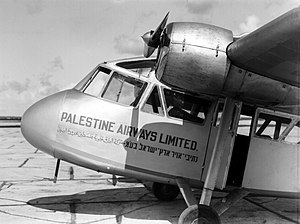Short Scion
| S.16 Scion/Scion II | |
|---|---|
 |
|
| Palestine Airways Pobjoy Short Scion, 1938 | |
| Role | Light transport landplane/floatplane |
| Manufacturer |
Short Brothers Pobjoy Airmotors Ltd. |
| Designer | Arthur Gouge |
| First flight | 18 August 1933 |
| Status | Retired |
| Number built | 22 Scion: 5 Scion II: 17 |
| Variants | Short S.22 Scion Senior |
The Short S.16 Scion and Scion II were 1930s British two-engine, cantilever monoplanes built by Short Brothers and (under licence) by Pobjoy Airmotors and Aircraft Ltd. in Rochester, Kent between 1933 and 1937. Altogether 22 Scion/Scion II aircraft were built and they provided useful service to operators working from small airstrips/water courses in many parts of the globe, including Europe, the Near and Middle East, Sierra Leone, Papua New Guinea and Australia. Many were impressed into the RAF during the Second World War, providing pilot ferry services, anti-aircraft co-operation and radar calibration duties. Of the civilian Scions, at least two were still operating in Australia in 1966, one having been re-engined with de Havilland Gipsy Minor engines.
The Scion and the later Scion II version were high wing cantilever monoplanes with fabric-covered metal wings and fuselage, the latter providing an enclosed cabin for the pilot and 5-6 passengers. The tail unit comprised a cantilever tailplane with a single fin and rudder. The prototype aircraft was powered by two 80 hp Pobjoy R radial engines; the production aircraft however were fitted with the 90 hp Pobjoy Niagara III radial engines. The engines in the Scion were mounted below the wing spar; in the Scion II they were raised so that the leading edge axis ran through the centre of thrust of the engines. Both the Scion and the Scion II were produced as either landplanes or floatplanes, the majority as landplanes (see the table below). On the landplanes the landing gear comprised a single wheel on each side of the fuselage, mounted on a vertical coil-spring and oleo leg inboard of the engine; there was a small castoring tailwheel mounted below the rear end of the fuselage.
The Scion was developed as a light transport for 5-6 passengers. The first flight of the prototype aircraft (G-ACJI) took place on 18 August 1933, piloted by Shorts' Chief Test Pilot John Lankester Parker. The first production aircraft (G-ACUV) was flown at the SBAC's airshow at Hendon in 1934. In 1935 the fifth production model was built as the revised model Scion II; the major improvement was the repositioning of the two engines as noted above; other changes included the provision of 6 passenger seats as standard (on the original Scion there was a folding seat for a sixth passenger if needed), an improved windscreen and better cabin windows. During the production of the Scions the company had opened a new factory at Rochester Airport and all Scion IIs were manufactured there, initially by Shorts, later by Pobjoy, first under licence and later under Shorts' ownership.
...
Wikipedia
